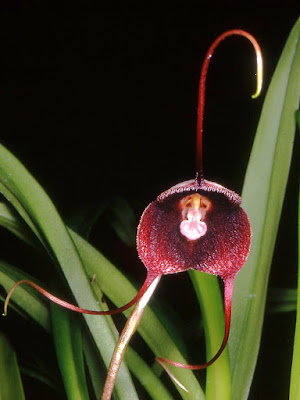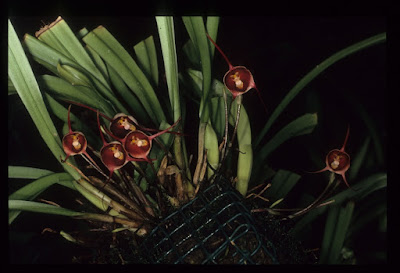Dracula benedictii is native to Colombia. These plants are found in the West and Central Cordillera in the Departments of Antioquia, Quindio and Risaralda...
Dracula benedictii also called as Benedict's Dracula, Dracula benedictii var. hubeinii, Dracula hubeinii, Dracula troglodytes, Masdevallia benedicti, Masdevallia troglodytes, is a species of the genus Dracula. This species was described by Luer in 1978.
IDENTIFY DRACULA BENEDICTII
Dracula benedictii is native to Colombia. These plants are found in the West and Central Cordillera in the Departments of Antioquia, Quindio and Risaralda. In the Antioquia Department, they were collected near Medellín and Sonsón at an altitude of 2300-2400 m. In the Quindio Department they were collected along the Barbas River at an altitude of 2180 m. In the Risaralda Department, they grow along the Risaralda River and near Cerro Luccero at 2000-2300m, and at Quebrada La Congoja and near Pueblo Rico at an altitude of 1700-2000 m.
It is a cool to cold growing epiphyte, which reaching 15-21 cm in height, with slender, erect, ramicauls enveloped basally by 2 to 3 loose, tubular sheaths and carrying a single, apical, erect, thinly coriaceous, very narrowly obovate to linear, acute, gradually narrowing below into the conduplicate, subpetiolate base, 13-18 cm leaf.
Benedict's Dracula blooms in the spring and summer on a congested, purplish, horizontal to descending, 3" (7.5 cm) long, successively few flowered inflorescence arising form low on the ramicaul with bracts at each joint of the scape and tubular floral bracts. The flowers are opened successively. The white petals of the outer whorl are colored light purple on the outside and purple-black to brown on the inside. The depression created by the flattened petals (synsepal) is white with purple spots. The inner whorls are white and have purple spots. The lip is white, tinged pink, and the rod is yellowish white. Sepals are transversely oval, concave, connected to each other by edges, forming a bucket-shaped corolla. The blunt tops of the sepals, sharply narrowing, turn into thin, straight blackish tails 2.0-3.5 cm long. The petals are oval, small. The lip is shaped like a spoon, concave. In the center of it there is a tubercle, from which on each side one or two veins depart. Edges of the lip are even, slightly curved inwards.
DRACULA BENEDICTII CARE AND CULTURE
Cultural information should only be used as a guide, and should be to be adapted to suit you. Your physical location; where you grow your plants, how much time you have to devote to their care, and many other factors, will need to be taken into account. Only then can you decide on the cultural methods that best suit you and your plants.
Light:
Dracula benedictii needs a light level of 12,000-18000 lux. The light should be filtered and dispersed, and the plants should not be exposed to the direct sunlight of the midday sun. Strong air movement should be ensured all the time.
Temperature:
Throughout the year, the average day temperature is 22-24 ° C, the night 9-11 ° C, and the daily difference is 11-14 ° C.
Humidity:
Benedict's Dracula needs the humidity of 70-75% throughout the year.
Substrate, growing media and repotting:
Dracula benedictii must be mounted or planted into hanging baskets or mesh pots. These plants are also usually grown in hanging baskets lined with moss sphagnum and filled with a loose, quickly drying substrate containing cut sphagnum moss or perlite to retain moisture and charcoal, which prevents souring the substrate and relaxes it.
It is recommended to repot annually. Some breeders recommend using only loosely packed sphagnum moss from New Zealand, but using this material repotting should be done every 9-12 months, especially when high-mineralized water is used for watering. When the moss begins to decompose, the balance of trace minerals is dramatically disturbed which can lead to plant damage. Regardless of the substrate used, the plants must be repotted when the substrate begins to degrade or when the plants grow out of the container. Repotting should be carried out when new roots begin to grow, because then the plant will stabilize in the shortest possible time. This is usually done at the end of winter or early spring, but it can be done at any time, if it does not interfere with flowering.
Watering:
Dracula benedictii should often be watered during active growth, but excellent drainage should be ensured, and the ground around the roots can never be soggy or damp.
Fertilizer:
In the growing season, weekly or every two weeks use 1/4-1/2 of the recommended dose of fertilizer for orchids. You can use a balanced fertilizer throughout the year, but also can use high-nitrogen fertilizer from spring to mid-summer, and then until the end of autumn, high-phosphoric fertilizer.
Rest period:
In winter, Dracula benedictii need less water, but they should not dry out completely, or stay out of water for too long. Sufficient level of hydration should ensure fairly frequent morning fogging between occasional light watering. Fertilization should be reduced or eliminated until spring, when new roots begin to grow and regular watering is resumed.

















COMMENTS